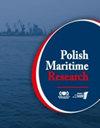导波在船舶结构健康监测中的可行性研究
IF 2
3区 工程技术
Q2 ENGINEERING, MARINE
引用次数: 0
摘要
船舶和海上结构在严重腐蚀退化的环境中运行,难以提供持久的腐蚀防护。船级社建议定期测量厚度,从而更换结构部件,以确保结构在使用寿命期间的完整性。测量通常使用超声波测厚仪进行,这种方法需要对腐蚀的结构部件进行多次测量。否则,收集的数据不足以准确评估腐蚀退化程度。本研究旨在进行数值和实验分析,以验证使用引导超声波来确定船舶腐蚀结构部件的腐蚀退化程度。该研究结合了基本的反对称Lamb模式,由附加在加强型板上预选点的压电换能器激发,代表了典型的船舶结构部件。试样暴露于加速的海洋腐蚀退化中,分析了退化程度对飞行波时间的影响。研究表明,导波是一种很有前途的结构构件腐蚀诊断方法。以高信噪比为特征的信号已被捕获,即使在传感器之间相对较远的距离。这证明了该方法可以适用于更大范围的船舶结构监测。本文章由计算机程序翻译,如有差异,请以英文原文为准。
Guided Waves in Ship Structural Health Monitoring – A Feasibility Study
Abstract Ships and offshore structures operate in a severe corrosion degradation environment and face difficulty in providing long-lasting corrosion protection. The Classification Societies recommend regular thickness measurements leading to structural component replacements, to ensure structural integrity during service life. The measurements are usually performed using ultrasonic thickness gauges and such an approach requires multiple measurements of the corroded structural components. Otherwise, the collected data are insufficient to precisely assess the corrosion degradation level. This study aims to perform numerical and experimental analyses to verify the use of guided ultrasonic waves in defining the corrosion degradation level of the corroded structural components of a ship. The study incorporates the fundamental antisymmetric Lamb mode, excited by piezoelectric transducers attached at the pre-selected points on stiffened panels, representing typical structural ship components. The specimens are exposed to accelerated marine corrosion degradation, the influence of the degree of degradation on the wave time of flight being analysed. The study indicates that guided waves are a promising approach for diagnosing corroded structural components. The signals characterised by a high signal-to-noise ratio have been captured, even for relatively long distances between the transducers. This proves that the proposed approach can be suitable for monitoring more extensive areas of ship structures by employing a single measurement.
求助全文
通过发布文献求助,成功后即可免费获取论文全文。
去求助
来源期刊

Polish Maritime Research
工程技术-工程:海洋
CiteScore
3.70
自引率
45.00%
发文量
20
审稿时长
>12 weeks
期刊介绍:
The scope of the journal covers selected issues related to all phases of product lifecycle and corresponding technologies for offshore floating and fixed structures and their components.
All researchers are invited to submit their original papers for peer review and publications related to methods of the design; production and manufacturing; maintenance and operational processes of such technical items as:
all types of vessels and their equipment,
fixed and floating offshore units and their components,
autonomous underwater vehicle (AUV) and remotely operated vehicle (ROV).
We welcome submissions from these fields in the following technical topics:
ship hydrodynamics: buoyancy and stability; ship resistance and propulsion, etc.,
structural integrity of ship and offshore unit structures: materials; welding; fatigue and fracture, etc.,
marine equipment: ship and offshore unit power plants: overboarding equipment; etc.
 求助内容:
求助内容: 应助结果提醒方式:
应助结果提醒方式:


